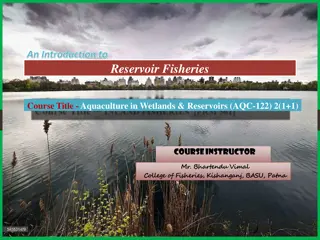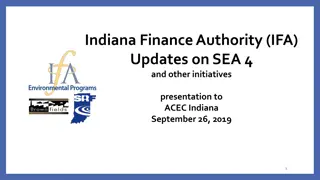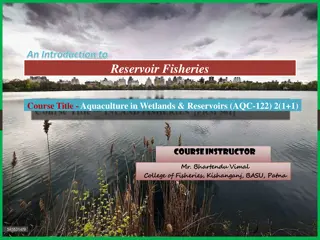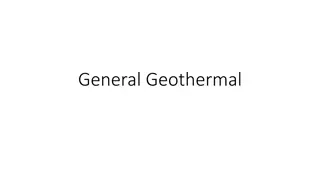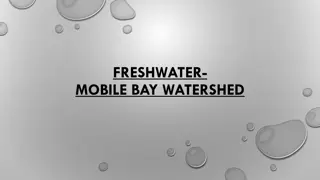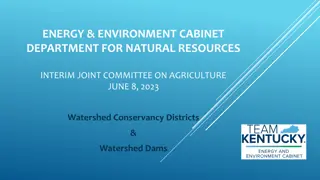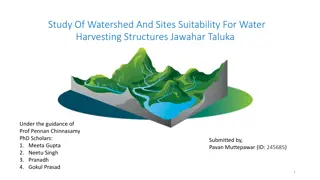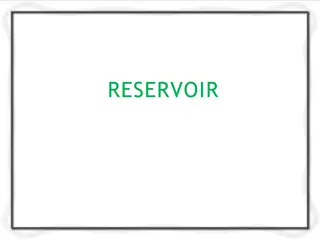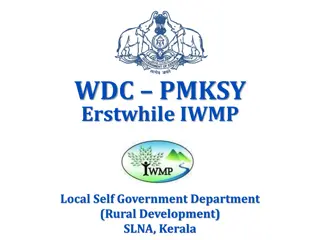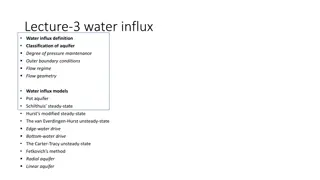Water Quality Predictors for Key Indiana Reservoirs - Indiana Watershed Leadership Academy Final Project Presentation
This project delves into the impact of climate change on water supplies, focusing on key Indiana reservoirs. Through data mapping and literature research, the aim is to identify water quality predictors for ensuring a reliable water supply for the well-being of society. By analyzing key reservoirs like Shafer, Freeman, and Patoka, valuable insights into water quality management are being explored.
Download Presentation

Please find below an Image/Link to download the presentation.
The content on the website is provided AS IS for your information and personal use only. It may not be sold, licensed, or shared on other websites without obtaining consent from the author. Download presentation by click this link. If you encounter any issues during the download, it is possible that the publisher has removed the file from their server.
E N D
Presentation Transcript
Water Quality Predictors for Key Indiana Reservoirs Indiana Watershed Leadership Academy Final Project Presentation Garrison Inn Ft. Harrison State Park Indianapolis, IN 20 May 2015 By Morgan Bennett Carol Newhouse Kelsey Owens
Motivation for this Project Climate changes are affecting water supplies across the nation and globally Growth and well-being of society is dependent on readily available water supply Current efforts and/or future needs to build water supply reservoir(s) in Indiana Wondering if history had anything to teach us
Discovery Steps List of Impoundments/Reservoirs in Indiana Mapping of Impoundments and their Watersheds Data Gathering from On- and Off-line Sources
First Step List of Impoundments/Reservoirs in Indiana Over 600 lakes/reservoirs in state Easily 150+ impoundments 21 major river impoundments 16 large water supply impoundments 35 local/state/federally owned 11 other working impoundments 75+ privately owned impoundments Narrowed list to most similar waterbodies
Basic Literature Search (online) Removed host of small water supply reservoirs and recreational impoundments 1.Brookville Lake a.Mounds SRA and Quakertown SRA 16,445 acres - 5,260-acre lake b.The area was purchased by the federal government for flood control and to provide a place for wildlife and recreation. c.Brookville Lake Dam (National ID # IN03017) is a dam in Brookville Township, Franklin County, Indiana, just north of Brookville, in the southeastern part of the state. d.The earthen dam was constructed in 1974 by the United States Army Corps of Engineers with a height of 181 feet and 2800 feet long at its crest.[1] It impounds the East Fork Of Whitewater River for flood control and storm water management. The dam is owned and operated by the Louisville District, Great Lakes and Ohio River Division of the Corps of Engineers. e.The riverine reservoir it creates, Brookville Lake, has a normal water surface of 8.2 square miles, a maximum capacity of 359,600 acre-feet, and normal storage of 184,900 acre-feet.[2] Recreation includes boating, hiking, hunting, and fishing (for bluegill, largemouth bass, smallmouth bass, striped bass, catfish, walleye, crappie, muskellunge, trout, and white bass).[3] Adjacent facilities include the Mounds State Recreation Area and the Whitewater Memorial State Park. Removed few cooling water reservoirs Ended up with 18 key reservoirs to consider
Key Reservoirs Shafer Freeman Kokomo #2 Morse Eagle Creek Geist Cecil M. Harden Cagles Mill Patoka
Key Reservoirs Cedarville J. Edward Roush Mississinewa Salamonie Prairie Creek Brookville Lemon Monroe Mounds
Second Step Mapping of impoundments and their watersheds Online tools Google Maps Indiana Maps Defining data layers Scale
Prairie Creek 1:6400 Some with rather small watersheds (Group 1) Size relation = 11.3% 1 acre of water drains <9 acres of land Best example
Geist Reservoir Most have moderately sized watersheds (Group 2) 1:250,000
Geist Reservoir Size relationship 1.0-2.0% (Geist = 1.3%) 1:250,000
Geist Reservoir 1 acre of water drains 75-100 acres of land 1:250,000
Kokomo #2 1:250,000
Kokomo #2 Few have rather large to humongous watersheds draining into them (Group 3) Size relationship = 0.5% or less 0.42% Kokomo 1 acre of water drains 238 acres of land (Kokomo) Cedarville 1 acre of water drains 2,000 acres Shafer & Freeman 1 acre drains 10,000 acres These are the hardest working bodies of water in Indiana
Hard working? How well do they fulfill the purpose(s) for which they were built? Parameters might be okay for hydroelectric use Or problematic for water storage use (storm or drinking), due to decreased storage volumes Or challenging for those with drinking water intakes
Map View Group 1 (ratio >3.0%) Group 2 (ratio 1.0-2.0%) Group 3 (ratio < 0.5%)
Prairie Creek Row crops (brown) and pasture/hay (yellow) Forested near lake (green) Small amount development along county roads
Highly developed shore vs. ag shore Uniformly mixed woods and pastures with a scattering of row crops
Proposed Mounds Reservoir in Madison County Size = 2,100 acres Drains 259,840 acres
Proposed Mounds Reservoir in Madison County Lots of agricultural land Plus urban / commercial / industrial use areas
Proposed Mounds Reservoir Encompasses seventeen 12-digit HUCs (PC had 1)
Third Step Data gathering from off- and online sources IU/SPEA website (1988-2014) 2014 List of Waterbody Impairments Historic files from IDEM Lake sediment and fish tissue sampling National Eutrophication Survey (EPA) Pertinent correspondence USGS and other reports Volunteer data
Trophic Information and Designated Use Support Water Quality Indicators for Lake Lemon Indicator Value Data Source Last Updated Area (Acres) 1650 * 2008 Trophic Status Eutrophic * 2008 Trophic Trend Fluctuating * 2008 Support for Designated Uses Recreational Use Not Assessed ** 2008 Fishable Use Impaired: 5B ** 2008 Aquatic Life Use Not Assessed ** 2008 Total Number of Impairments 1 ** 2008 Cause of Impairment(s), If Any Mercury in Fish Tissue *** 2008
Data Crunching Comparing individual water quality parameters (collected to calculate Indiana Trophic State Index scores) PO4 Secchi Nitrogen DO Plankton
At First, Data Gaps Epilimnion and hypolimnion data unwieldy Water column averages easier and in keeping with other state lake assessments Historical data consulted for outliers and representativeness
Waterbody to Watershed Ratio Area : Area Volume : Area Adapted from Hoosier Riverwatch image
Reservoir Area : Watershed Area Resulted in multiple groups Surface Area (acres) 1,216 8,880 10,750 1,650 5,260 2,110 1,510 1,800 1,800 2,100 1,400 2,655 3,210 484 900 245 1,535 1,291 Drainage Area (acres) 10,752 107,520 276,480 45,376 242,560 138,240 103,680 140,160 144,343 259,840 187,520 355,840 516,480 114,560 458,880 488,320 10,938,880 10,900,480 Ratio of Lake Area: W'shed Area 11.31% 8.26% 3.89% 3.64% 2.17% 1.53% 1.46% 1.28% 1.25% 0.81% 0.75% 0.75% 0.62% 0.42% 0.20% 0.05% 0.01% 0.01% Lake Name Creek/River Impounded Prairie Creek Reservoir Prairie Creek Patoka Lake Lake Monroe Lake Lemon Brookville Cecil M. Harden Eagle Creek Reservoir Geist Reservoir Morse Mounds Cagles Mill Lake Salamonie Mississinewa Kokomo J.E. Roush Cedarville Freeman Shafer Patoka River North Fork of Salt Creek Beanblossom Creek East Fork Whitewater River Big Racoon Creek Eagle Creek Fall Creek Cicero Creek White River Mill Creek Salamonie River Mississinewa River Wildcat Creek Wabash River St. Joseph River Tippecanoe River Tippecanoe River
Res. Volume : Wshed Area Fell nicely into three (3) groups (#2 >> Mounds group) Lake Volume (acre-feet) 18,240 133,200 188,125 16,500 38,924 25,750 18,750 21,180 21,175 Drainage Area (acres) 10,752 107,520 276,480 45,376 242,560 138,240 103,680 140,160 144,343 259,840 187,520 355,840 516,480 114,560 458,880 488,320 10,938,880 10,900,480 Ratio of Lake Volume: W'shed Area 16.96% 12.39% 6.80% 3.64% 1.60% 1.86% 1.81% 1.51% 1.47% 0.00% 1.49% 1.31% 1.08% 0.30% 0.33% 0.02% 0.02% 0.01% Lake Name Creek/River Impounded Prairie Creek Reservoir Patoka Lake Lake Monroe Lake Lemon Brookville Cecil M. Harden Eagle Creek Reservoir Geist Reservoir Morse Mounds Cagles Mill Lake Salamonie Mississinewa Kokomo J.E. Roush Cedarville Freeman Shafer Prairie Creek Patoka River North Fork of Salt Creek Beanblossom Creek East Fork Whitewater River Big Racoon Creek Eagle Creek Fall Creek Cicero Creek West Fork White River Mill Creek Salamonie River Mississinewa River Wildcat Creek Wabash River St. Joseph River Tippecanoe River Tippecanoe River ---- 28,000 46,480 55,650 3,388 15,300 980 26,140 13,168
Pulling it All Together Cursory graphing to see which data appeared to be closely related
Pulling it All Together or not so closely related
Pulling it All Together Compared average values by parameter Trophic Score Index 70 60 50 40 30 20 10 0
Secchi Disk 2.5 2 1.5 Meters 1 0.5 0 Brookville appears as outlier here, due to lake not being stratified. Apparently lower gate was open causing mixed water column throughout.
% Water Column with DO of 0.1 or greater 90 80 70 60 50 40 30 20 10 0
% Sat. of DO at 5 Depth 160 140 120 100 % at 5 Feet 80 60 40 20 0
Blue-Green Algae Dominance (Taste and Odor) 100 90 80 70 % of Cells / L 60 50 40 30 20 10 0
Plankton Count 140,000,000 120,000,000 Number of Plankton 100,000,000 80,000,000 60,000,000 40,000,000 20,000,000 -
Pulling it All Together Determined which parameters showed significant difference between three groups Secchi Disk Reading 1.40 1.20 1.00 meters 0.80 0.60 0.40 0.20 0.00 Group 1 Group 2 Group 3
Pulling it All Together Determined which ones correlated to water quality Total Phosphorus 0.20 0.18 0.16 0.14 mg-P/L 0.12 0.10 0.08 0.06 0.04 0.02 0.00 Group 1 Group 2 Group3
Nitrate + Nitrite as N 1.80 1.60 1.40 mg-N/L 1.20 1.00 0.80 0.60 0.40 0.20 0.00 Organic Nitrogen Group 1 Group 2 Group 3 1.60 1.40 1.20 1.00 0.80 0.60 0.40 0.20 0.00 Group 1 Group 2 Group 3
Chlorophyll a 30.00 25.00 20.00 g/L 15.00 10.00 5.00 0.00 Group 1 Group 2 Group3
Chlorophyll a 30.00 M O U N D S 25.00 20.00 g/L 15.00 10.00 5.00 0.00 Group 1 Group 2 Group3
Lessons Learned Working with water data as a whole There is a lot of data available, but it is scattered and not all is available online Improvements in lake trophic scores following Indiana s ban on phosphates have maintained themselves Drawing water from different lake depths effects DO and stratification Watershed size : waterbody volume ratio s effect on water quality was supported by Indiana s reservoir data despite the significant differences in land use and topography across Indiana s reservoirs
More Lessons Learned Importance of erosion control Need for nutrient Sewers are better than septic tanks Use of various forms of technology (hard and soft) Murphy says the greater your need for particular software package is, the more likely it will be taken offline for maintenance or upgrades Working as a team!!!
Whats Next? Comparing additional impoundments which have similar size ratios to see if they respond the same More complete assessment of land use types and impervious surfaces (running various models) Running better statistics on groups and parameters to verify significant differences Further data analysis to determine anomalies vs. general variability Create online guidance document for public use




